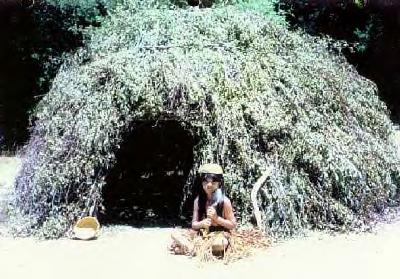The kindergarten-through-sixth-grade Encinitas Union
School District, where La Costa Heights is located, calls the program service-learning. It's a hybrid of the traditional
notions of off-campus field trips and community service volunteerism, such as beach cleanups.
All Encinitas
district third-graders will have at least one service-learning outing during the year. State Superintendent of
Public Instruction Delaine Eastin has set a goal of having at least a quarter of the state's school districts providing
students with such an opportunity by the end of this school year.
In Encinitas,
service-learning has to fill a community need, complement regular classroom lessons, encourage civic responsibility
and link thestudents to community organizations.
The third-graders
in Encinitas study local history, and that's where Quail Botanical Gardens came in. A Kumeyaay village exhibit
is under construction-- there in a canyon planted with sage scrub, deerweed and scrub oaks.
While many
schools time their lessons on Indians to coincide with Thanksgiving, the partnership between La Costa Heights and
Quail goes deeper. The students won't get into the full swing of their Indian history studies until the spring,
but the installation of the Quail exhibit offered a unique opportunity for students' participation.
The kids'
job this week was to thatch the 'ewaa. They bent tules, long green reeds, over the willow skeleton of the 'ewaa.
Whether they thought it was educational or just plain fun, all the children helped.
"It's
neat to learn about the Indians," said Kaitlin Sugg, 8. "We're going to get to build a Kumeyaay home."
Sandra Contreras,
8, said she liked learning outside school because sometimes she gets tired listening to Mrs. Allmann reading books.
Trevor Davey,
8, said the appeal of the trip for him was, "You don't have to work -- not like writing." But he bundled
and folded as many tules as everyone else.
Bugbee, 51,
a Quail consultant and the curator of the Kumeyaay Cultural Center in Alpine, was the living link to the past.
He wore his long brown hair in a pony tail, like his ancestors, and he also wore a Padres cap. He told them that
the area around Palomar Airport Road is about where Luiseno territory ended and Kumeyaay land began.
He described
the old tribal rules: Boys had to give away the kill from their hunts, girls were to spend the day with their grandmothers
learning to tend the home, and anyone who disobeyed the rules faced the embarrassment of having an uncle travel
from a neighboring village to reprimand the offender.
Times have
changed, and Allmann and the chaperons enforced the rules Tuesday, telling the kids, "Brian, that (lunch bag)
is not a weapon," and "Guys, you're not supposed to be eating right now, it's not snack time," and
"No whipping."
As for modern
American Indians, Bugbee said, "We go hunting at Vons, Ralphs, and we go for the quick kill at Jack In The
Box."
Allmann's
class will take the experiences of building a hut and meeting a real American Indian back to class as a real-life
lesson to add to their book study of local tribes. Quail Gardens got 36 little hands to help hatch part of a hut
that might stand in the exhibit for several years.
Encinitas
has paid for its service-learning program for the past five years with federal money channeled through the state.
The $85,000 to run the program this year ultimately comes from the Corporation for National Service; the same agency
runs the Americorps program that has 13 volunteers at Quail who planted the willow branches in the ground for the
huts. |
